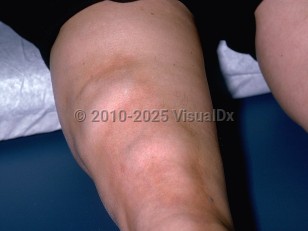Eosinophilic fasciitis in Adult
Alerts and Notices
Important News & Links
Synopsis

Classically, EF presents with symmetrical edema and woody induration of the affected extremities sparing the hands, feet, and face, which progresses rapidly to fibrosis, induration, and a peau d'orange appearance. EF is usually accompanied by pain and joint contractures resulting in a decreased range of motion and paresthesias. The skin in EF is often bound down, accentuating the natural planes between muscles and vasculature, and revealing linear depressions along superficial veins causing the groove sign.
The cause of the disease is currently unknown. EF affects both sexes, with women more commonly affected than men. White individuals have been most commonly reported to suffer from EF. The disease has occurred in patients of all ages, from childhood to older adults, but most patients are between ages 30 and 50. A history of strenuous physical activity preceding the clinical findings of EF occurs in approximately 30% of patients. Some researchers have hypothesized that certain environmental exposures, including drugs, toxins, and infections (Borrelia burgdorferi), may be potential causes. In addition, thrombocytopenia, aplastic anemia, myelodysplastic syndromes, and other myeloproliferative disorders are associated with EF. The presence of monoclonal gammopathy has been detected in 16%-33% of patients with EF.
Trunk involvement and the presence of peau d'orange have been reported to be associated with a poorer prognosis. While some authorities believe that EF overlaps with deep morphea and scleroderma, features that distinguish EF are a peripheral eosinophilia (in 60%-80% of patients), hypergammaglobulinemia (in 20%-70% of patients), and an absence of Raynaud phenomenon that is common to systemic sclerosis. In a retrospective study, 21 of 60 patients (35%) had concurrent plaque morphea. Antinuclear antibody (ANA) titers are normal. Erythrocyte sedimentation rate (ESR) is usually elevated.
Codes
M35.4 – Diffuse (eosinophilic) fasciitis
SNOMEDCT:
24129002 – Fasciitis with eosinophilia syndrome
Look For
Subscription Required
Diagnostic Pearls
Subscription Required
Differential Diagnosis & Pitfalls

Subscription Required
Best Tests
Subscription Required
Management Pearls
Subscription Required
Therapy
Subscription Required
Drug Reaction Data
Subscription Required
References
Subscription Required
Last Updated:01/08/2023

